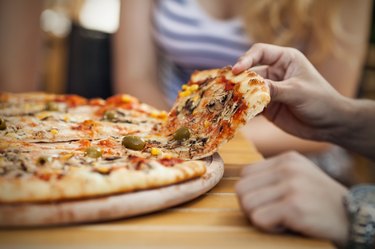
The chlorine you get through your diet is mostly in the form of chloride, most of which comes from the amount of salt, or sodium chloride, you eat. Because people often get too much salt, they usually get plenty of chloride to meet their body's needs. You need chloride for forming digestive juices in the stomach and maintaining the correct balance of fluids in your body. The adequate intake level for adults is 2,000 milligrams per day.
Fruits and Vegetables
Video of the Day
Chloride is found naturally in some vegetables, including tomatoes, celery, olives, lettuce and seaweed. It's also found in many canned vegetables due to the salt added to help preserve them. For example, canned peas can have as much as 510 milligrams of chloride per serving, but the same amount of fresh peas only has about 8 milligrams. Just five olives canned in brine can provide 3,000 milligrams of chloride, and two dried figs have 170 milligrams. Other than some dried fruits, most fruits tend to contain only small amounts of chloride. However, some raw fruits and vegetables may have traces of chlorine on them due to being washed in a chlorine bleach solution for sanitization, according to Oklahoma State University. They are washed in water after being sanitized, so levels should be very low. You'd be able to taste excessive levels of chlorine on your produce before they became dangerous.
Video of the Day
Meat, Poultry and Seafood
In the United States, poultry is often chilled in a chlorine water tank to help disinfect it and limit the risk of salmonella. The chlorine gets washed off, so any traces should be minimal. Salted meats, cold cuts, hot dogs and other processed meats are among the highest sources of chloride in the diet. Prawns, canned tuna, scallops, called salmon, raw oysters, mussels, lobster, crab and cod all provide significant amounts of chloride to your diet. Ham, bacon, corned beef, organ meats, salami and sausages are also high in chloride.
Dairy Products
Many dairy products provide at least small amounts of chloride, but cheeses tend to have the most chloride. A serving of cheddar that is slightly less than an ounce provides 1,060 milligrams, and the same amount of Camembert has a whopping 2,320 milligrams. Butter is also high in chloride because it's seasoned with salt.
Other Foods
Milk chocolate, toffee, peanut butter, canned soups, tomato sauce, mayonnaise, French dressing, dried coconut, roasted and salted peanuts, scrambled eggs and many baked goods are also sources of chloride. To minimize your chloride intake, look for foods that are low in sodium because sodium and chloride are so often found together in processed foods.
- Asia Pacific Journal of Clinical Nutrition: Chlorine
- Oklahoma State University: Guidelines for the Use of Chlorine Bleach as a Sanitizer in Food Processing Operations
- NPR: European Activists Say They Don't Want Any U.S. 'Chlorine Chicken'
- MedlinePlus: Chloride in Diet
- Eating Well: Sodium Chloride
- Centers for Disease Control and Prevention: Sodium: The Facts